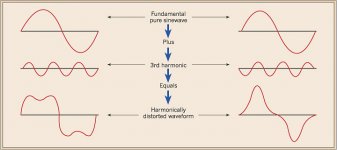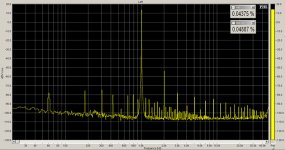In practical terms, how would you conduct this test?
I'm doing it with a soundcard and ARTA Limp. The cap-inductor in series compo connected to the recommended probe. For XO inductors, something like a 100n cap but you have to measure it.
I wasn't expecting you to actually use the cumbersome comparison method I detailed. 😱...gearing up for hobby appears expensive.
I'll need two multi meters and an audio sine wave generator.
Simply buy an LCR multimeter like the one to which I linked earlier.
This will measure the inductance (L) of an unknown inductor at a single frequency, as well as its resistance (R), which is good enough if you just want to replace it.
The L and R values are specified by the manufacturers of replacement inductors.
It is only when designing loudspeaker crossovers that more sophisticated measurement techniques may be required.
Last edited:
1. As has been pointed out, there is no such thing as a poor quality inductor. It is a case of horses for courses i.e. selecting the appropriate inductor type to suit the intended application.Are there poor quality Inductors in circulation which, if identified could be replaced?
I was hoping for a simple way of assessing the performance of Inductors.
Maybe, my only way forward is to study electronics, in particular crossover design, and measurement of Loudspeaker performance so I can properly assess deficiencies and improvements.
2. As you may have gathered by now, there is no 'simple' way of assessing inductor performance.
3. I wouldn't say 'maybe', I would say this is a definite requirement to continue the upward trend of your learning curve.
P.S. The minuimum information you require to know about choosing inductors for loudspeaker crossovers is given here: COILS FOR DIY LOUDSPEAKERS
If you really want to delve into the mysteries of inductors, Willys HiFi supply helpful downloadable files containing information about general inductor characteristics, testing methods etc. Audio Inductors - Air Core - Willys-Hifi Ltd
https://cdn.shopify.com/s/files/1/0809/2387/files/Inductors_for_passive_filtercircuits.pdf?5141
https://cdn.shopify.com/s/files/1/0809/2387/files/Inductors_basics.pdf?5141
https://cdn.shopify.com/s/files/1/0809/2387/files/Inductors_testing_interpretation.pdf?5141
Hi AllenWhile you have your computer set up to find resonance, you might use it to look at waveforms.
I had a bit of a search.
Waveforms seems to cover much more than specifically testing HiFi resonance.
Would love reference to some specific sites you might recommend.
thanks
You should decide what you want to measure. I guess you don't want to measure hysteresis in general, there is plenty of illustrative text on that.
Maybe you want to look at a waveform (think sine wave), to visually judge whether it is distorted. Maybe you want to do a frequency analysis to see the same thing in an easier to read format.
Maybe you should become familiar with REW as it does both of these. Apply a sine wave signal, and feed your speaker terminal voltage back to your sound card. Ensure its safety, use a voltage divider to reduce the level as required, get your grounding right.
Maybe you want to look at a waveform (think sine wave), to visually judge whether it is distorted. Maybe you want to do a frequency analysis to see the same thing in an easier to read format.
Maybe you should become familiar with REW as it does both of these. Apply a sine wave signal, and feed your speaker terminal voltage back to your sound card. Ensure its safety, use a voltage divider to reduce the level as required, get your grounding right.
Attachments
When you refer to "HiFi resonance", I suspect you may not be thinking of the type of "resonance" to which AllenB referred.Waveforms seems to cover much more than specifically testing HiFi resonance.
An inductor in series with a capacitor constitutes what is called a 'series resonant circuit'.
In a series resonant circuit there is a frequency at which the ohm value of the inductor is equal to the ohm value of the capacitor. This frequency is known as the frequency of resonance, or the 'resonant frequency'.
That's right, it was mentioned for finding the value of inductance. Creating this resonance makes it easy to locate the frequency, then you pull out your calculator.
To the OP:
The posters here have given you great advice.
An inductor is characterized using Ls/Rs.
The wire gauge and coil size will play in the frequency dependence of ls/Rs.
An inductor with an iron core may enter into hysteresis, which can introduce harmonics.
While a litz inductor can provide excellent results, it may not duplicate what it replaces.
Never put an inductor against a conductive surface, it lowers inductance as frequency increases and raises resistance.
Take it from one who sweeps the floor...🙂
In
The posters here have given you great advice.
An inductor is characterized using Ls/Rs.
The wire gauge and coil size will play in the frequency dependence of ls/Rs.
An inductor with an iron core may enter into hysteresis, which can introduce harmonics.
While a litz inductor can provide excellent results, it may not duplicate what it replaces.
Never put an inductor against a conductive surface, it lowers inductance as frequency increases and raises resistance.
Take it from one who sweeps the floor...🙂
In
- Home
- Design & Build
- Parts
- Selecting Air Core Inductors?

